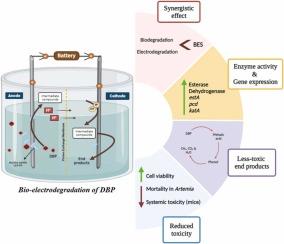Harnessing landfill-derived Bacillus subtilis (LLS-04) for bio-electrodegradation of di-butyl phthalate: Comprehensive toxicity assessment across multiple biological models
IF 12.2
1区 环境科学与生态学
Q1 ENGINEERING, ENVIRONMENTAL
引用次数: 0
Abstract
Di-butyl phthalate (DBP), a pervasive environmental contaminant, poses significant ecological and health risks due to its persistence and toxicity. This study investigates the potential of a landfill-derived Bacillus subtilis strain (LLS-04) in bio-electrodegradation of DBP, alongside a comprehensive toxicity assessment across multiple biological models. Bio-electrodegradation efficiency was compared to biodegradation and electrodegradation, revealing that bio-electrodegradation achieved a remarkable 98.57 % reduction in DBP concentration significantly outperforming the other methods. This enhanced degradation was attributed to improved microbial activity and enzyme production, as indicated by higher protein content and increased esterase and dehydrogenase activities in the bio-electrodegradation system. The optimized conditions facilitated efficient degradation, with HPLC-MS/MS analysis confirming the breakdown of DBP into non-toxic end products via a proposed metabolic pathway. A comprehensive toxicity assessment, including in-silico analysis, in-vitro cytotoxicity and brine shrimp lethality assays, demonstrated a significant reduction in toxicity of BES treated effluent compared to DBP untreated effluent. Furthermore, in-vivo toxicity studies using animal model supported these findings, demonstrating reduced toxicity in the BES treated effluent compared to the DBP untreated effluent. Overall, these findings highlight the potential application of bio-electrodegradation in bioremediation strategies for phthalate pollution, offering an effective solution for reducing both DBP concentration and its environmental toxicity.

利用垃圾填埋场产生的枯草芽孢杆菌(LLS-04)对邻苯二甲酸二丁酯进行生物电降解:多种生物模型的综合毒性评估
邻苯二甲酸二丁酯(DBP)是一种普遍存在的环境污染物,由于其持久性和毒性,对生态和健康构成了重大风险。本研究调查了源自垃圾填埋场的枯草芽孢杆菌菌株(LLS-04)在生物电降解 DBP 方面的潜力,同时对多种生物模型进行了全面的毒性评估。将生物电降解效率与生物降解和电降解进行比较后发现,生物电降解可显著降低 DBP 浓度 98.57%,明显优于其他方法。生物电降解系统中蛋白质含量较高,酯酶和脱氢酶活性增强,这表明微生物的活性和酶产量得到了提高,从而增强了降解效果。优化的条件促进了高效降解,HPLC-MS/MS 分析证实 DBP 通过拟议的代谢途径分解为无毒的最终产品。全面的毒性评估(包括室内分析、体外细胞毒性和盐水虾致死试验)表明,与未经 DBP 处理的污水相比,经 BES 处理的污水毒性显著降低。此外,使用动物模型进行的体内毒性研究也证实了这些发现,与 DBP 未处理污水相比,BES 处理污水的毒性有所降低。总之,这些研究结果凸显了生物电降解在邻苯二甲酸盐污染生物修复策略中的潜在应用,为降低 DBP 浓度及其环境毒性提供了有效的解决方案。
本文章由计算机程序翻译,如有差异,请以英文原文为准。
求助全文
约1分钟内获得全文
求助全文
来源期刊

Journal of Hazardous Materials
工程技术-工程:环境
CiteScore
25.40
自引率
5.90%
发文量
3059
审稿时长
58 days
期刊介绍:
The Journal of Hazardous Materials serves as a global platform for promoting cutting-edge research in the field of Environmental Science and Engineering. Our publication features a wide range of articles, including full-length research papers, review articles, and perspectives, with the aim of enhancing our understanding of the dangers and risks associated with various materials concerning public health and the environment. It is important to note that the term "environmental contaminants" refers specifically to substances that pose hazardous effects through contamination, while excluding those that do not have such impacts on the environment or human health. Moreover, we emphasize the distinction between wastes and hazardous materials in order to provide further clarity on the scope of the journal. We have a keen interest in exploring specific compounds and microbial agents that have adverse effects on the environment.
 求助内容:
求助内容: 应助结果提醒方式:
应助结果提醒方式:


